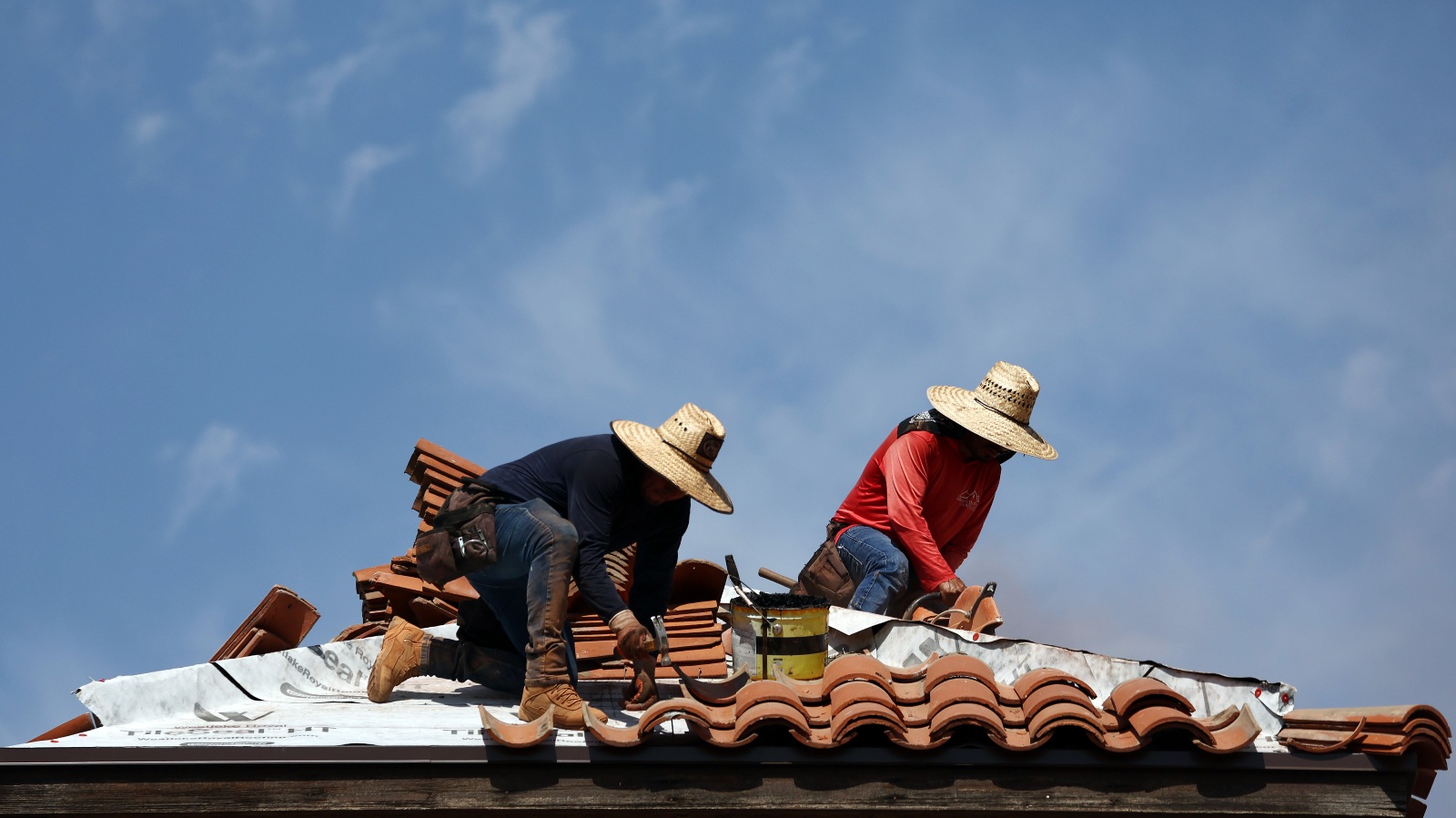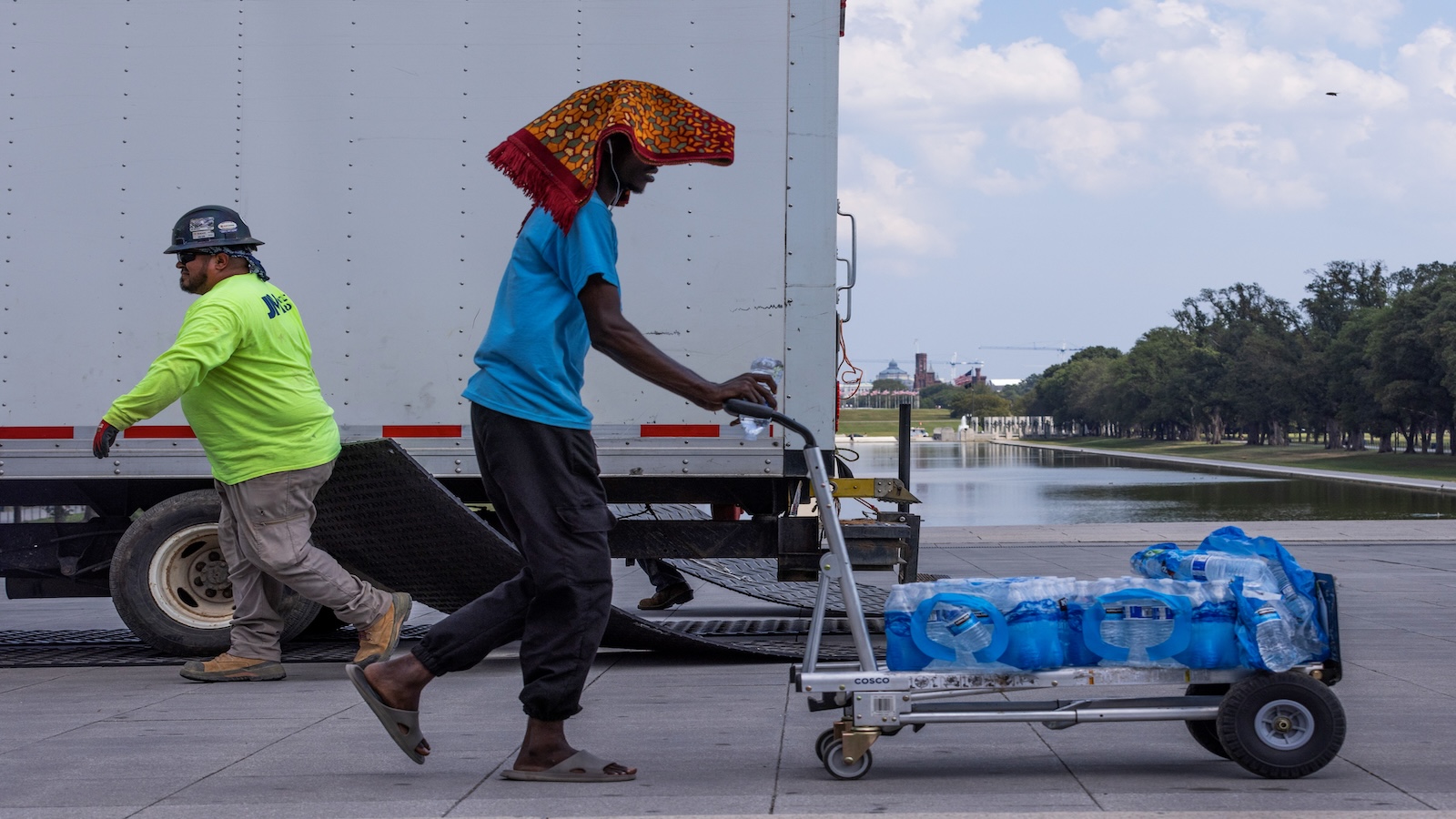In the summer of 2011, Victor Ramirez was working at a Walmart warehouse in Mira Loma, California when he suddenly passed out. When he came to, he was lying on the floor confused as to what had just happened, and his head hurt terribly. Although he received no medical attention (his boss simply told him to go home if he felt too unwell to continue working), he knew that this sudden loss of consciousness was caused by the unrelenting heat of the warehouse.
“When it’s hot outside, it feels hotter inside the warehouse because of all the machinery,” Ramirez told Grist in Spanish. “If it’s 110 degrees outside, it’s 10 degrees hotter inside.” The heat was exacerbated by a lack of water and poor air circulation inside the warehouse.
Later that summer he felt similar symptoms again. His face was red, he was sweating profusely, and his head hurt. This time, he knew it was a sign of heat stress and told his supervisor, who asked Ramirez why he was “acting stupid” and why he wasn’t working faster. In both cases, no one provided first aid or advised them to go see a doctor. (Walmart declined to comment on Ramirez’s experience and said the site is operated by a third party, Schneider Logistics. A representative for Schneider Logistics did not respond to Grist’s request for comment.)
“I’m nervous for myself and my daughter,” said Ramirez, whose family relies on his wages to pay their bills. He now works in another warehouse, but the 55-year-old is constantly worried about what might happen to him due to dangerous heat exposure at work. Inadequate access to water, limited air conditioning and cavalier attitudes toward heat exposure are common in his industry. Ramirez’s fears are rekindled every year as temperatures begin to rise and summer approaches.
Ramirez has good reason to be concerned. The extreme heat Deadliest Extreme Weather Events, the threat level is intensifying due to climate change. The U.S. Bureau of Labor Statistics reports: Every year, dozens of workers die from workplace heat exposure.A total of 436 people have died from 2011 to 2021, but federal officials say that Widely perceived as underrated. However, no national regulations exist to protect indoor or outdoor workers from heat. This led Ramirez to fight for protections in Southern California and others to advocate for stronger protections across the country.
“Pay attention to the workers,” Ramirez said. “We matter.”
As of this month, the Occupational Safety and Health Administration (OSHA) is one step closer to creating the nation’s first national heat stress rule for workers. This institution announce The process of drafting federal heating regulations should have begun three years ago. Proposal submitted on June 11th It is submitted to the White House Office of Management and Budget (OMB) for review, a significant step that could signal that the rule could be finalized relatively soon. But legal experts and labor advocates are concerned about the legal, bureaucratic, and political challenges that lie ahead for OSHA’s rulemaking process, especially in an election year. A Trump victory in November could spell doom for the federal heat stress rule, and even if there is no change in administration in 2025, OSHA’s rule could be subject to legal challenges in the courts.
Experts, Advocates and Agency Hosted Panel The standard suggests that workers and employers could be required to train them on how to recognize and treat heat stress symptoms. Workers Temperature thresholds that trigger heat illness prevention programs that require new areas to gradually acclimate to dangerous temperatures and more frequent, longer breaks. OSHA previously said the rule’s mandate could begin to take effect when the heat index approaches 80 degrees Fahrenheit. Bloomberg Law Reported.
Such rules could make a difference. “OSHA regulates the entire workforce,” said Cary Coglianese, director of the Penn Program on Regulatory Affairs and a professor at the University of Pennsylvania School of Law. “Heat affects all outdoor workers and some major industries, including construction, travel and transportation.”
The draft proposal being submitted to the White House marks the beginning of a review process that could take about 90 days, although it could be longer or shorter, according to Coliagnese. “A lot depends on how much pressure there is within the administration to enforce the rules,” Coglianese said.
The White House’s Office of Intelligence and Regulatory Affairs did not respond to Grist’s request for comment on when he expects to complete his review. “Heat is a serious workplace hazard that threatens the health, safety and lives of workers every year,” an OSHA spokesperson said in a statement, adding that enacting federal heat standards is a priority for the Department of Labor. “As of Tuesday, June 11, the proposed rule is under review by the Office of Management and Budget, bringing us one step closer to providing workers with the protections they need and deserve.”

Workers are dying from the extreme heat. Why is there no law to protect them?
Once the review is complete, details of the proposed rule will be made public, at which point the public will have at least 60 days to submit comments on the rule to the agency. Coglianese cautions that with a rule with such far-reaching implications, OSHA is likely to receive a lot of comments.
At the end of the comment period, OSHA will need time to consider and address all concerns raised by the public. Coglianese said how long it takes the agency to do this “depends on the input that comes in, the priorities, and how vexing some of the issues are.” Another White House review will follow after OSHA produces an updated draft. If all goes well, the rules will be finalized and published in the Federal Register.
OSHA’s recent progress in this process is welcome news to many advocates who have spent years fighting for heat protection, including Nezahualcoyotl Xiuhtecutli, senior grassroots advocacy coordinator for the National Sustainable Agriculture Coalition. Xiuhtecutli served on the working group. Making recommendations to OSHA It helps inform the proposed rules, but he worries the rulemaking process could drag on beyond this year.
“It could take years,” Xiuhtecutli said. “I think the Biden administration is interested in making this happen, so I hope they move quickly.”

Representative Greg Casar, a Democrat from Texas who staged a day-long thirst-quenching campaign last year to draw attention to the urgent need to protect workers, agreed that time is of the essence in extreme heat.
“We need this heat protection as soon as possible. We needed it yesterday.” Kasar said. He added that he was confident the Biden administration would “get this done right and fast.”
But the years-long fight by workers and their supporters to get national heat standards on the table now faces a looming obstacle: the upcoming presidential election.
In Coglianese’s opinion, it is unlikely that the rules will be finalized before November, or even until January next year. He added that once Donald Trump takes office, he will likely suspend all federal rules that have not yet been finalized. Even if federal heating rules are “barely passed” at the end of Biden’s term, Congress will You will have the power to override the rules. Under the Congressional Review Act — and Coglianese expects Trump to approve such an invalidation. (The Trump campaign did not respond to Grist’s request for comment.)
Advocates share Coglianese’s concerns. “[If] “If Biden loses, he could stay in office indefinitely or just die,” Xiutecutli said. “I hope it continues quickly because people’s lives depend on it,” he said.
Expert predictions about the future of the rule reflect the recent politicization of heat waves. Earlier this year, Florida Governor Ron DeSantis enacted legislation that: anti-immigration bill It includes a law that prohibits local governments from requiring employers to enact protective measures. Like breaking shade or water.a product for outdoor workers. The bill was very similar to Texas law. Prohibits local governments from making such regulationsIt passed last summer.
But other communities went the opposite way. In Phoenix, A citywide ordinance was adopted last March. Mandates a heat safety plan for all companies that contract with the city.
At the state level, only six states — California, Colorado, Nevada, Minnesota, Oregon, Washington — have enacted thermal protection regulations for outdoor workers, and three of these states have established similar protections for indoor workers.
California is the most recent to do so. Just passed a bill To enforce thermal protection for indoor workers, employers must provide breaks, cooling areas, and water when indoor temperatures reach 82 degrees Fahrenheit. If temperatures exceed 87 degrees Fahrenheit, companies may need to install cooling units, adjust work schedules, provide more breaks and slow workers’ production rates. Tim Shadix, legal director of the Warehouse Worker Resource Center, a California-based nonprofit, describes it as the “most comprehensive” set of indoor heat protection regulations in the country. “Certainly when the rubber hits the road will depend on how employers respond to it and how they enforce it,” Shadix said.
But Shaddix expects the OSHA regulations will go further than the California regulations by setting lower temperature limits that trigger heat exposure requirements. Shaddix thinks California’s limits are “too high” and lower federal limits would be “a very good thing for workers.”
But Xiuhtecutli of the OSHA working group doesn’t expect the proposed federal rule to include a national limit on temperature. “They could leave it up to localities to decide,” he said. The Supreme Court on Friday overturned a 1984 ruling known as the “Chevron doctrine,” which allowed federal agencies to more easily regulate the environment, public health, workplace safety and other issues. The overturning of that precedent weakens the administration’s ability to enact policy changes through federal regulations, which would make it harder to pass national heat standards for workers. May be exposed to more legal challenges.
Coglianese describes the road to federal heating standards as an “uphill battle.” But in his view, the case for federal protections is becoming clearer. “I think in the long run, the heat is coming. The politicians who try to fight it are likely to ultimately lose.”
Then we ask, “How many lives will be lost due to heat waves?” A record was set in 2023 2,300 people across the United States have died of heat-related causes, and this summer could be even hotter than last year. “I hope we can take steps to reduce those numbers, and I think most Americans would feel the same way,” Coglianese said.






